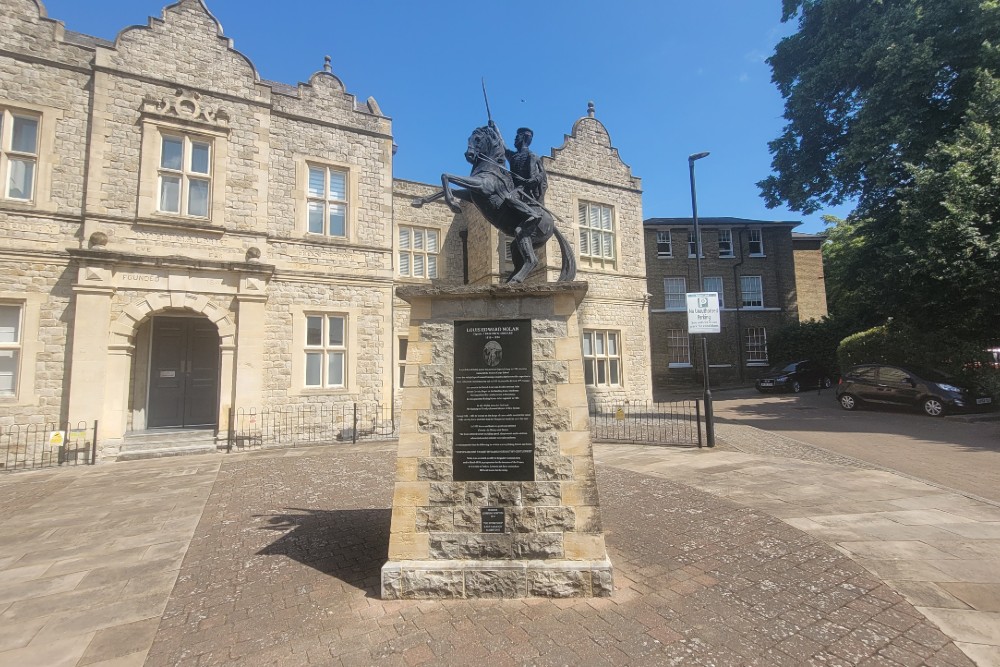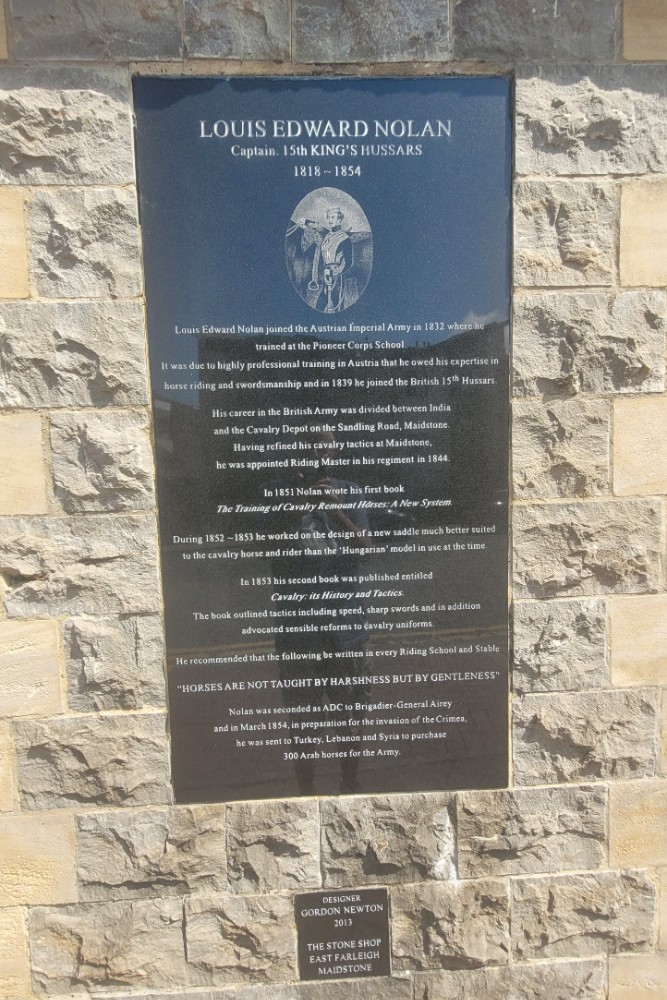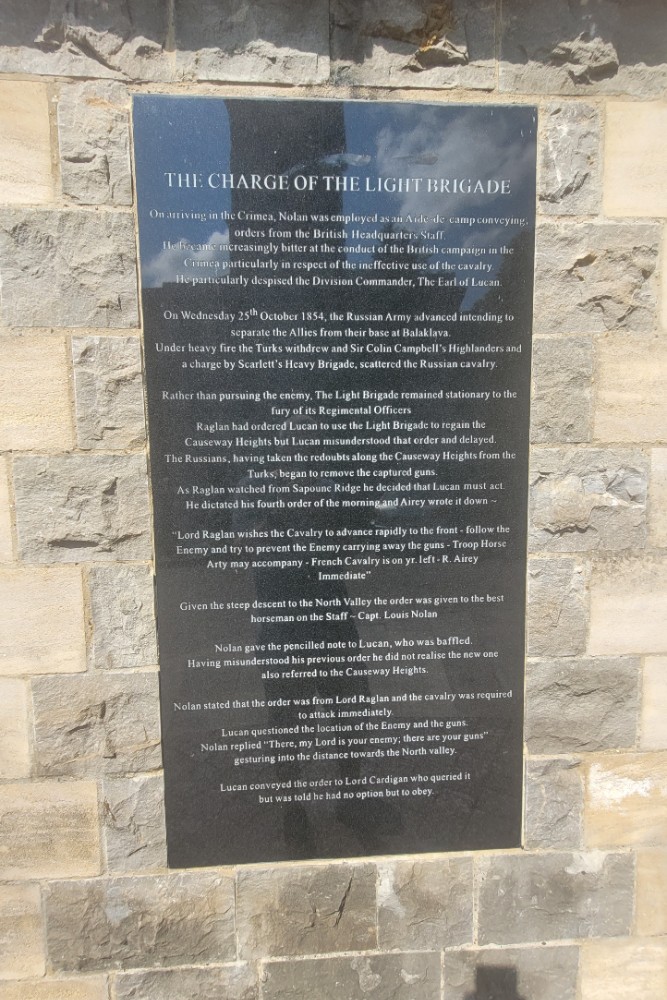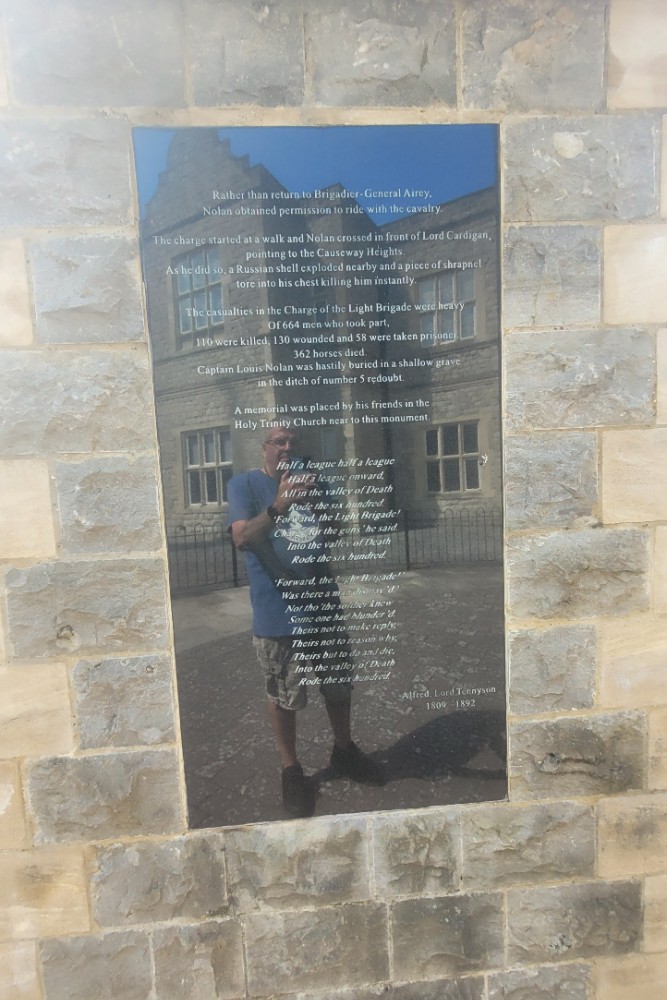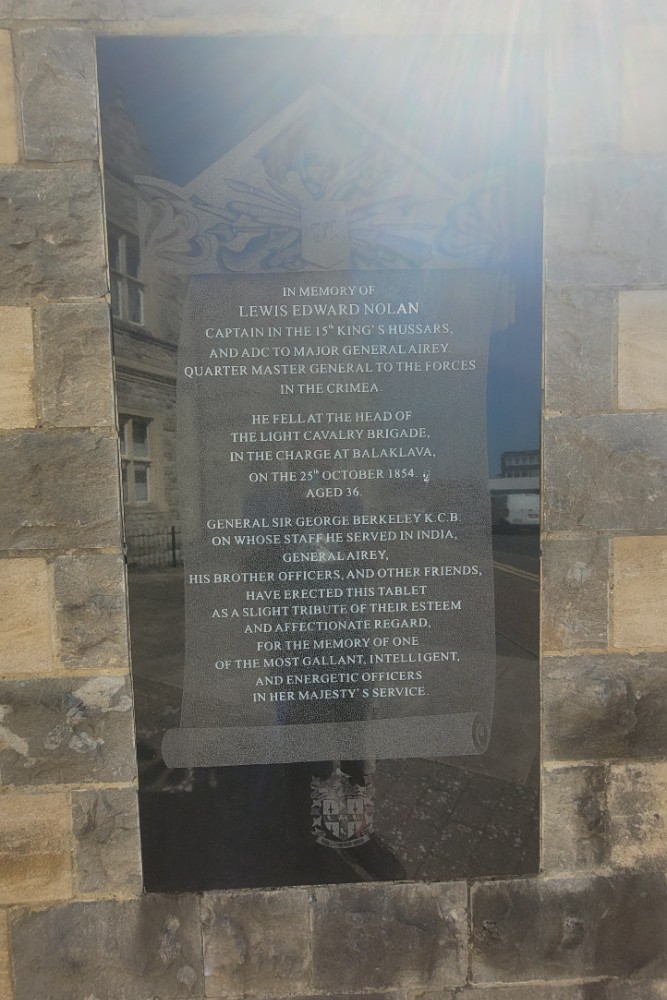Statue Louis Edward Nolan
"Louis Edward Nolan
Captain 15th King's Hussars
1818-1854
Louis Edward Nolan joined the Austrian Imperial Army in 1832 where he trained at the Pioneer Corps School. it was due to highly professional training in Austria that he owed his expertise in horse riding and swordsmanship and in 1839 he joined the British 15th Hussars. His career in the British Army was divided between India and the Cavalry Depot on the Sandling Road, Maidstone. Having refined his cavalry tactics at Maidstone he was appointed Riding Master in his regiment in 1844. In 1851 Nolan wrote his first book 'The training of cavalry remount horses: A new system'
During 1852-1853 he worked on the design of a new saddle much better suited to the cavalry horse and rider than the 'Hungarian' model in use at the time. In 1853 his second book was published entitled 'Cavalry: its history and tactics. This book outlined tactics including speed, sharp swords and in addition advocated sensible reforms to cavalry uniforms. He recommended that the following be written in every Riding School and Stable @ Horses are not taught by harshness but by gentleness'
Nolan was seconded as ADC to Brigadier-General Airey and in March 1854, in preparation for the invasion of Crimea, he was sent to Turkey, Lebanon and Syria to purchase 300 Arab horses for the Army"
"In memory of Lewis Edward Nolan, Captain in the 15th King's Hussars and ADC to Major General Airey, Quarter Master General to the forces in the Crimea. He fell at the head of the Light Brigade in the charge at Balaklava, on the 25th October 1854, aged 36. general Sir George Berkeley K.C.B. on whose staff he served in India, General Airey, his brother officers, and other friends have erected this tablet as a slight tribute to their esteem and affectionate regard for the memory of one of the most gallant, intelligent and energetic officer's in Her Majesty's service"
"On arriving in the Crimea, Nolan was employed as an Aide de Camp conveying orders from the British Headquarters Staff. He became increasingly bitter at the conduct of the British campaign in Crimea, particularly in respect of the ineffective use of the cavalry. He particularly despised the Division Commander, The Earl of Lucan.
On Wednesday 25th October 1854, the Russian Army advanced intending to separate the Allies from their base at Balaklava. Under heavy fire the Turks withdrew and Sir Colin Campbell's Highlander and a charge by Scarlett's Heavy Brigade, scattered the Russian cavalry. Rather than pursuing the enemy, the Light Brigade remained stationary to the fury of the Regimental Officers. Raglan had ordered Lucan to use the Light Brigade to regain the Causeway Heights but Lucan misunderstood that order and delayed. The Russians, having taken the redoubts along the Causeway Heights from the Turks, began to remove the captured guns. As Raglan watched from Sapounc Ridge he decided that Lucan must act. He dictated his fourth order of the morning and Airey wrote it down. 'Lord Raglan wishes the Cavalry to advance rapidly to the front- follow the enemy and try to prevent the Enemy carrying away the guns - Troop Horse Arty may accompany - French Cavalry is on yr left - R. Airey. Immediate' Given the steep descent to the North Valley the order was given to the best horseman on the Staff- Capt. Louis Nolan. Nolan gave the pencilled note to Lucan, who was baffled. Having misunderstood his previous order he did not realise the new one also referred to the Causeway Heights. Nolan stated that the order was from Lord Raglan and the cavalry was required to attack immediately. Lucan questioned the location of the Enemy and the guns. Nolan replied, 'There, my Lord is your enemy; there are your guns' gesturing into the distance towards the North Valley. Lucan conveyed the order to lord Cardigan who queried it but was told he had no option but to obey"
"Rather than return to Brigadier-General Airey, Nolan obtained permission to ride with the cavalry. The charge started as a walk and Nolan crossed in front of lord Cardigan, pointing to the Causeway Heights. As he did so, a Russian shell exploded nearby and a piece of shrapnel tore into his chest killing him instantly.
The casualties of the Charge of the Light Brigade were heavy. Of 664 men who took part, 110 were killed, 130 wounded and 58 were taken prisoner. 362 horses died. Captain Louis Nolan was hastily buried in a shallow grave in the ditch of number 5 redoubt. A memorial was placed by his friends in the Holy Trinity Church near to this monument.
Half a league, half a league
Half a league onward,
All in the valley of Death
Rode the six hundred
'Forward, the Light Brigade!
Charge for the gun's' he said
Into the valley of Death
Rode the six hundred.
'Forward, the light Brigade!'
Was there a man dismay'd
Not tho 'the soldier knew
Some one had blunder'd
Theirs not to make reply
Theirs not to reason why,
Theirs but to do and die,
Into the valley of Death
Rode the six hundred'
Alfred, Lord Tennyson 1809-1892"
Do you have more information about this location? Inform us!
Source
- Text: Sharky Ward
- Photos: Anthony (Sharky) Ward
Nearby
Museum
Point of interest
- Roll of Honour Trinity Church - Maidstone
- Captain Louis Nolan Info Board - Maidstone
- Firewatchers Post Maidstone - Maidstone
Monument
- World War I Memorial Maidstone - Maidstone
- Maidstone Museum Statues - Maidstone
- Memorial Window St Faith's - Maidstone
Cemetery
- Maidstone Cemetery WW1 Cross of Sacrifice - Maidstone
- British War Grave Maidstone Cemetery - Maidstone
- Commonwealth War Graves WW2 Plot Maidstone Cemetery - Maidstone
Fortification
- Pillbox FW3/28A Allington - Allington
- MG-Pillbox Allington - Allington
- Pillbox FW3/22 East Farleigh - East Farleigh
